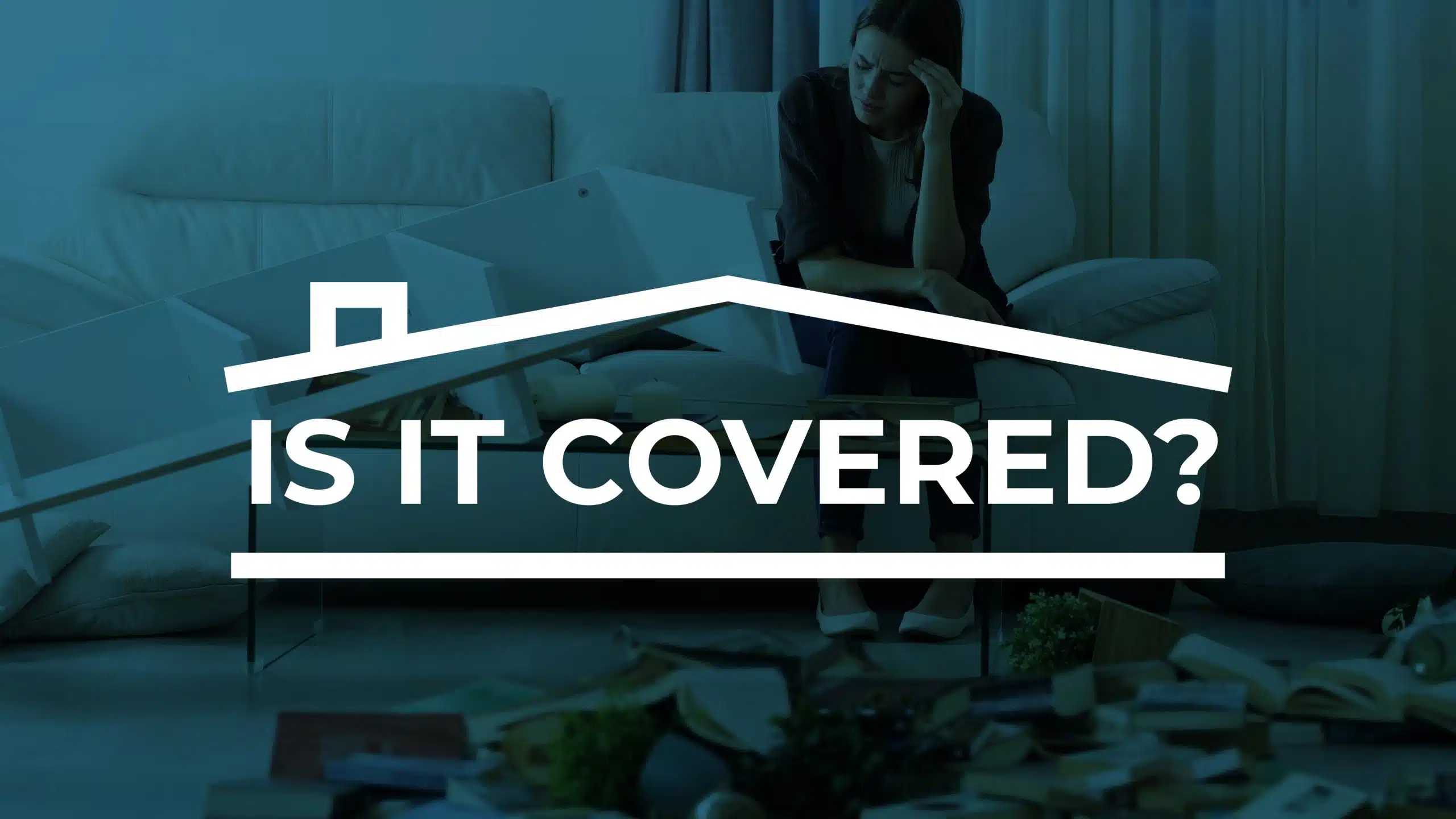Many people are unclear about the differences between acts of theft, vandalism, and burglary, as well as whether or not coverage for those perils is available under the three main policy formats: Basic, Broad, and Special. Theft, Vandalism, and Burglary insurance can be limited, and the cost of a single break-in for a vacant or renovated property can be over four times the national average, so it is important to understand the differences and limitations.
Welcome to our “Is It Covered?” series. For a fuller introduction of the series, read HERE. We hope these quick reads will help you increase your understanding of your insurance coverage, clear up confusion and help you avoid preventable losses! Please bear in mind that insurance policies may vary, so always check your own policy for language specific to your covered property. If you have coverage questions, don’t hesitate to call your agent who will be happy to assist you!
What are the differences between acts of theft, vandalism, and burglary?
Below are definitions from an insurance perspective. Other industries may define these differently.
Theft: the taking and carrying away of the personal goods or property of another without permission.
Vandalism & Malicious Mischief: the intentional injury or destruction of property without theft. For example, someone spray painting the walls with graffiti, breaking sinks and toilets, or punching holes in walls.
Burglary: includes damage to your property caused by burglars, but not theft of property. An example would be the damage done to an entry door when burglars pry it open.
Is it considered vandalism if a tenant purposefully damages a unit?
No, a tenant intentionally damaging your property is not considered Vandalism from an insurance perspective. Depending on the laws of the state, they may have committed a crime, but your tenant is not a stranger who has broken into your home. Tenant damage is treated differently within the insurance contract because you have allowed them to be a caretaker of your home through the lease agreement.
Basic, Broad, and Special – Which coverage is available under each format?
Though the most common policy formats used for real estate investment properties tend to be Basic and Special Forms, below is a summary of what coverages are available under each of the three policy formats.
Basic Form: Includes Vandalism & Malicious Mischief (VMM)
Broad Form: Includes VMM and adds Burglary Damage
Special Form: Includes VMM, Burglary Damage, and adds Theft
Learn more about these three coverage formats here.
Can insurance coverage for Theft, Vandalism, or Burglary be limited?
Yes. Unlike perils such as fire, these coverages may have their own sublimit underneath the property coverage limit. Even if you have insurance coverage for Theft, VMM, or Burglary, the limits of coverage may still be restricted for just those perils. So, while you may have insured your property for $100,000, you may only have $30,000 worth of coverage for Theft, Vandalism (VMM), or Burglary. Your deductible may also differ for those losses. Check your policy for specific details, or contact your agent if you have questions.
Are contractor tools covered in my insurance policy?
If they aren’t covered under another policy, tools may be covered. Coverage can vary widely in this area though, so it is best to check the details of your specific policy. Some Builder’s Risk policies include coverage for equipment and uninstalled materials but may have limits on the type of equipment – bulldozers and other heavy equipment may not be included, or there may be no coverage for tools at all.
How could vacancy affect my ability to get Theft and Vandalism coverage?
If your property is vacant, your insurer may require certain protective safeguards to reduce the risk of theft and vandalism. They may require your property to be “boarded and secured,” meaning all windows and glass doors should be protected against glass breakage. They also may require you or your property manager to continue maintaining the property (e.g., cut the lawn, perform routine repairs, stay current with local codes) and visit weekly to ensure the property remains secure. If these protective safeguards are not in place at the time of loss, insurance coverage for Theft, VMM, or Burglary may be excluded.
What if I forget to tell my insurer about a change in occupancy?
Some standard insurance carriers don’t insure vacant properties, which could become very problematic if you have any type of loss. Even if a carrier insures vacant properties, your coverage may be reduced if you don’t report a change in occupancy within a specified time frame. This is because the insurance contract they have with you is written for a specific stated risk and its related premium. The new vacant status puts the insurer at an increased risk, for which there is also an increased cost. If they haven’t agreed to the new risk, and you haven’t paid them for that new risk, they aren’t bound to pay claims on that new risk. As such, it is crucial to report any changes in occupancy to your insurer as soon as possible.
How do I add coverage for Theft, Vandalism, or Burglary?
While Vandalism is typically included in all three formats, you will need to either purchase Theft or Burglary coverage in addition to the Basic Form or purchase a Special Form policy. When you consider how many more perils are insured, it’s easy to understand the additional cost that comes with Special Form coverage.
What does the technical lingo for this exclusion look like in my policy?
Sample policy language may look similar to this:
Basic Form policy
“When Basic is shown in the Declarations, Covered Causes of Loss means the following…
Vandalism, meaning the willful and malicious damage to, or destruction of, the described property.
We will not pay for the loss or damage caused by or resulting from theft, except for building damage caused by the breaking in or exiting of burglars.”
Special Form policy
“We will not pay for loss of or damage to property, as described and limited in this section…
Building materials and supplies not attached as part of the building or structure, caused by or resulting from theft.”
Sublimits for the Theft and VMM Perils
“When the Special Cause of Loss form is applied a combined sublimit applies for Vandalism and Malicious Mischief and Theft at $30,000 per loss, per location.”
Reductions in coverage related to occupancy status
“If a scheduled occupied location is found at the time of Loss to have been vacant for more than 60 days, the perils of VMM and/or Theft are now excluded from coverage.”
As insurance policies may vary, please check your own policy for language specific to your covered property.
How much can theft, vandalism, or burglary damage cost me?
Theft and vandalism losses can vary from a few hundred dollars to tens of thousands. It all depends upon what a thief is after and what they can carry out before the threat of discovery scares them off. The items that thieves are looking for will not surprise you: copper pipes, appliances, A/C condensers, HVAC systems, water heaters, sinks, toilets, cabinetry, etc. If your house is a rehab, add contractor tools and uninstalled materials to that list. Anything that can be re-sold is fair game.
Vandalism can also be quite costly. A vandal can do as much damage as a thief if they go so far as to break plumbing systems or damage appliances. Those items may not be removed from the property, but they may be damaged to the point of becoming unusable.
What can I do to protect my investment?
First, know what is in your policy. Read the sections of your insurance policy that address Theft, Vandalism, and Burglary. It is important to know both what you are and are not covered for. If you don’t understand your coverage or have questions, don’t hesitate to ask your agent, who would be happy to help you!
Make your property appear lived in. If your property looks lived in, the chance of someone breaking in decreases.
Layer your security. Add extra lighting, door reinforcement, an alarm, and more to your property.
Monitor vacant properties closely. Drive by the property regularly to make sure the house is still secure.
Enlist the neighbors. Have neighbors contact the police if they see any suspicious activity or unfamiliar faces.
Maintain a good working relationship with tenants. Use a thorough screening process and build a good relationship during their stay.
Make sure your tenant understands their personal property isn’t covered by your insurance. Require your tenants to carry renter’s insurance in the lease and enforce it.






